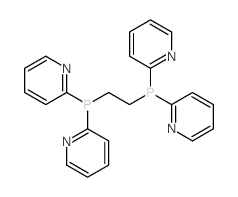1,2-BIS(DI(PYRIDIN-2-YL)PHOSPHINO)ETHANE
Modify Date: 2024-01-11 21:39:27

1,2-BIS(DI(PYRIDIN-2-YL)PHOSPHINO)ETHANE structure
|
Common Name | 1,2-BIS(DI(PYRIDIN-2-YL)PHOSPHINO)ETHANE | ||
|---|---|---|---|---|
| CAS Number | 106308-26-3 | Molecular Weight | 402.36900 | |
| Density | N/A | Boiling Point | N/A | |
| Molecular Formula | C22H20N4P2 | Melting Point | N/A | |
| MSDS | N/A | Flash Point | N/A | |
| Name | 2-dipyridin-2-ylphosphanylethyl(dipyridin-2-yl)phosphane |
|---|---|
| Synonym | More Synonyms |
| Molecular Formula | C22H20N4P2 |
|---|---|
| Molecular Weight | 402.36900 |
| Exact Mass | 402.11600 |
| PSA | 78.74000 |
| LogP | 2.83220 |
|
Section 1: Product Identification Chemical Name:1,2-Bis(di-2-pyridylphosphino)ethane, min. 98% CAS Registry Number:106308-26-3 Formula:C22H20N4P2 EINECS Number:none Chemical Family:organophosphine ligand Synonym:1,2-Bis(di-2-pyridylphosphano)ethane
Section 2: Composition and Information on Ingredients IngredientCAS NumberPercentACGIH (TWA)OSHA (PEL) Title compound106308-26-3100%no datano data Section 3: Hazards Identification Emergency Overview:Irritating to skin, eyes and respiratory tract. Primary Routes of Exposure:Inhalation, skin, eyes Eye Contact:Causes slight to mild irritation of the eyes. Skin Contact:Causes irritation to the skin Inhalation:Causes irritation to the nose, mucous membranes and respiratory tract Ingestion:No information on the physiological effects of ingestion. May be harmful if swallowed. Acute Health Affects:Irritating to skin, eyes and respiratory tract. Chronic Health Affects:No information available on long-term chronic effects NTP:No IARC:No OSHA:No SECTION 4: First Aid Measures Immediately flush the eyes with copious amounts of water for at least 10-15 minutes. A victim may need Eye Exposure: assistance in keeping their eye lids open. Get immediate medical attention. Wash the affected area with water. Remove contaminated clothes if necessary. Seek medical assistance if Skin Exposure: irritation persists. Remove the victim to fresh air. Closely monitor the victim for signs of respiratory problems, such as difficulty Inhalation: in breathing, coughing, wheezing, or pain. In such cases seek immediate medical assistance. Seek medical attention immediately. Keep the victim calm. Give the victim water (only if conscious). Induce Ingestion: vomiting only if directed by medical personnel. SECTION 5: Fire Fighting Measures Flash Point:no data Autoignition Temperature:no data Explosion Limits:no data Extinguishing Medium:carbon dioxide, dry chemical or foam If this product is involved in a fire, fire fighters should be equipped with a NIOSH approved positive pressure Special Fire Fighting Procedures: self-contained breathing apparatus and full protective clothing. Hazardous Combustion andIf involved in a fire, this material may emit irritating organic fumes Decomposion Products: Unusual Fire or Explosion Hazards: No unusual fire or explosion hazards SECTION 6: Accidental Release Measures Small spills can be mixed with vermiculite, sodium carbonate or other suitable non-combustible adsorbent and Spill and Leak Procedures: swept up. SECTION 7: Handling and Storage Handling and Storage:Store the material in a tightly sealed container. Keep in a cool, dry place. SECTION 8: Exposure Controls and Personal Protection Eye Protection:Always wear approved safety glasses when handling a chemical substance in the laboratory. Skin Protection:Wear protective clothing and gloves. Ventilation:Handle the material in an efficient fume hood. If ventilation is not available a respirator should be worn. The use of respirators requires a Respirator Respirator: Protection Program to be in compliance with 29 CFR 1910.134. Ventilation:Handle the material in an efficient fume hood. Additional Protection:No additional protection required. SECTION 9: Physical and Chemical Properties Color and Form:white powder Molecular Weight:402.37 Melting Point:no data Boiling Point:no data Vapor Pressure:no data Specific Gravity:no data Odor:none Solubility in Water:insoluble SECTION 10: Stability and Reactivity Stability:air and moisture stable Hazardous Polymerization:no hazardous polymerization Conditions to Avoid:none Incompatibility:oxidizing agents Decomposition Products:carbon dioxide, carbon monoxide, phosphorus and nitrogen oxides and organic fumes SECTION 11: Toxicological Information RTECS Data:No information available in the RTECS files Carcinogenic Effects:no data Mutagenic Effects:no data Tetratogenic Effects:no data SECTION 12: Ecological Information Ecological Information:No information available SECTION 13: Disposal Considerations Disposal:Dispose of according to local, state and federal regulations SECTION 14: Transportation Shipping Name (CFR):Non-hazardous Hazard Class (CFR):NA Additional Hazard Class (CFR):NA Packaging Group (CFR):NA UN ID Number (CFR):NA Shipping Name (IATA):Non-hazardous Hazard Class (IATA):NA Additional Hazard Class (IATA):NA Packaging Group (IATA):NA UN ID Number (IATA):NA SECTION 15: Regulatory Information TSCA:Not listed in the TSCA inventory SARA (Title 313):Title compound not listed Second Ingredient:none SECTION 16 - ADDITIONAL INFORMATION N/A |
| HS Code | 2933399090 |
|---|
| Precursor 2 | |
|---|---|
| DownStream 0 | |
| HS Code | 2933399090 |
|---|---|
| Summary | 2933399090. other compounds containing an unfused pyridine ring (whether or not hydrogenated) in the structure. VAT:17.0%. Tax rebate rate:13.0%. . MFN tariff:6.5%. General tariff:20.0% |
| Pyridine,2,2',2'',2'''-(1,2-ethanediyldiphosphinidyne)tetrakis |
| 1,2-bis(di-2-pyridylphosphino)ethane |
| 2,2',2'',2'''-(1,2-Ethanediyldiphosphinetriyl)Tetrapyridine |
| 1,2-bis(bis(2-pyridyl)phosphine)ethane |
| 1,2-bis[bis(2-pyridyl)phosphino]ethane |
| 1,2-Bis(di-pyridin-2-ylphosphino)ethane |

